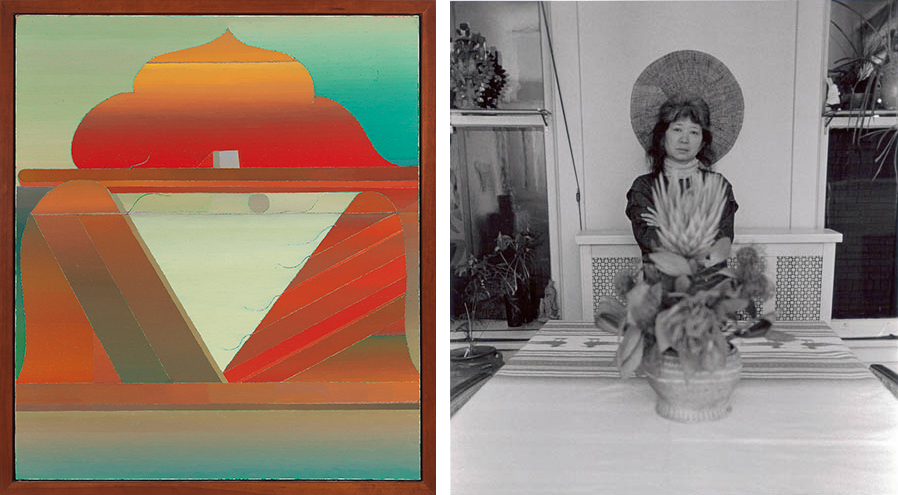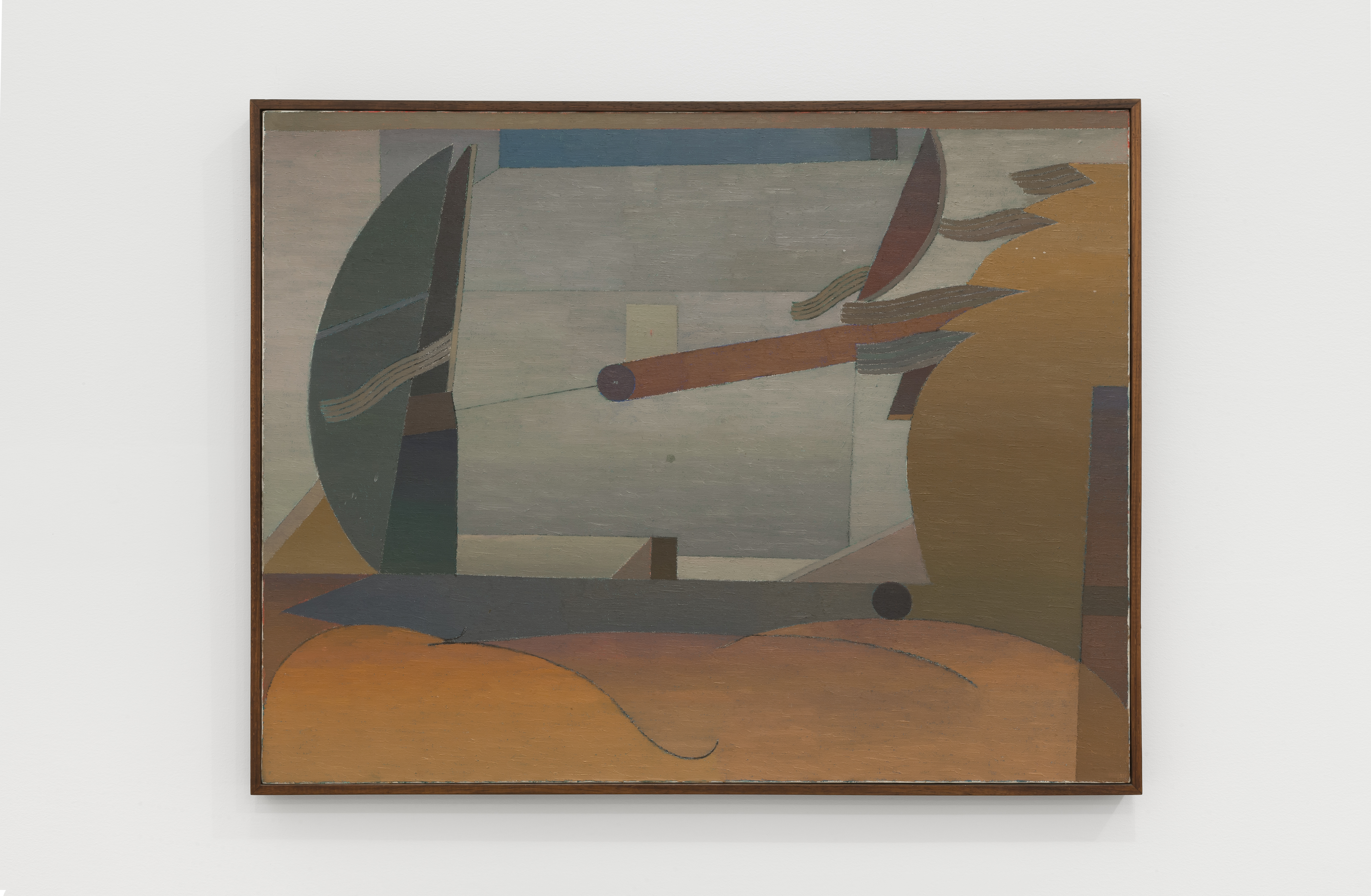In the 1950s, when she was in her early thirties, Miyoko Ito was “called an old lady painter, passe.” She recalled the slight when she was sixty and nearing the end of her life, yet still decades away from recognition. Now, thirty-five years after her death, her work looks positively avant-garde, for any time. Paintings from her most inventive period, the 1970s and early eighties, were recently the subject of “Heart of Hearts,” at Artists Space in New York, curated by Jordan Stein (the show originated at the Berkeley Art Museum and Pacific Film Archive). Ito’s work is brilliantly sui generis: it touches on the familiar styles of Surrealism, minimal abstraction, and synthetic cubism to create meditative color spaces of intermingling forms that allude to landscapes, sexual organs, and urban architecture.
For decades, Ito, who spent her adult life in Chicago, has been a kind of cult figure for certain painters and critics (myself included). She was an outlier: Ito made abstract paintings at a time when her adopted city was mostly interested in figuration, and unlike many of her younger peers, she did not exhibit with a consistent group of artists. She also made her finest work at a time when painting as a medium and Surrealism as a mode had been critically discredited.
Island in the Sun, 1978, exemplifies the qualities that make her work both prescient and, at the time, critically unfavorable. Like much of her painting, it comprises a vocabulary of colorful undulations, jutting triangles, cross-current patterns, semicircles, and short, wavy lines. It is thickly painted, each color mixed with a palette knife and usually applied from right to left. Slats of color form the primary structure—a triangle—and the entire construction rests atop multicolor horizontal planes, one blending into the next. The pale blue rectangle in the center of the painting indicates a window but above it sits an ominous mound that seems to recede into a space unconnected from the rest of the image. Island, like Ito’s other paintings, is a landscape that both entices (that bright red tip at the top of the mound) and discourages (all those steps to climb).
The works in this exhibition display great structural precision, with a delicacy worthy of Ito’s beloved Giorgio Morandi, whose still lifes are made up of soft forms bathed in a hazy light that seems always on the verge of fading away entirely. “When I approach a canvas I try to as much as possible keep my mind blank,” she once said. “And I draw with charcoal over and over and over again. I like the charcoal because it erases, and it also leaves traces. And eventually my eyes will pick up the leftover lines. And if I find the image I like, I’ll keep that image … I remember in the beginning it would take two or three weeks to find an image that I would want to paint.” Island in the Sun is rigorously composed, yet the picture becomes interesting because it remains slightly off-kilter. The lines that delineate the construction fade in and out; the luminous colors change gradually or suddenly; space opens up, but never in a literal sense—it is always, like the work of Paul Klee, a flat field. There is a sense that the final painting is the result of constant brushwork and deliberation, like a writer spending weeks on a single sentence. By the 1970s, Ito was in the studio seven days a week, all day; she typically made one painting at a time, completing one each month.
Center Stage, 1980, offers a tremendous amount of space within several circumscribed areas. The central area, which is the picture’s most serene space, sits on a perch and modulates from mauve to light pink to nude; these changing tones are framed by thick brown and blue curves, which, in turn, are surrounded by a band of color, lining three sides of the canvas, that alternates from purple to burnt orange to magenta. Ito seems to suggest both that maintaining calm requires a heavily fortified exterior and that even arriving at that space of peace entails traversing difficult, if not impossible, obstacles. Iliad, 1981, animates a Leger-like tube on the verge of entering a vaginal form atop amorphous fleshy hills. The atmosphere is autumnal; the action is unabashedly erotic. “I am essentially synthetic,” Ito said. “My roots are in synthetic cubism, but I don’t want that to show too much. And Chicago gave me a sense of surrealism, although it is not that obvious.” She was conscious that there was “content” in her paintings, by which she meant objects—such as (unintentional) landscapes, mirrors, chairs—but she clearly was most interested in forms that could not be easily described. She considered herself a person of circumscribed interests in the midst of a life that was, at times, a test of her own endurance. “it’s been a straight and narrow path all my life,” she said. “And it has been a long time.”
The eldest of two children, Ito was born in Berkeley, California, to Japanese parents in 1918, just after the end of World War I. Her time in California was spent the Japanese community, which kept itself separate as a preventative measure against the kind of persecution that was legislated two decades later. From 1923 to 1928, she lived with her mother, grandmother, and sister in Japan and recalled barely escaping the 1923 Tokyo earthquake, having gone to the countryside the day before. Ito excelled at reading, calligraphy, and watercolor painting in school, and though she didn’t consider it influential on her later work, it’s hard not to see that early education in achieving luminosity in color and fluidity in lines as crucial to her later paint application and attention to sinuous kanji-like marks. Ito was ill for essentially her entire time in Japan, so much so that she couldn’t walk; the cause was unknown: “It finally came out, after all these years, that it was probably a childhood nervous breakdown.” After returning to Berkeley, she attended the University of California, where she felt at home in the art department; she studied watercolor painting under now-obscure Western landscape masters such as Worth Ryder and Erle Loran. Ito was to graduate in May of 1942 but was sent in April to Tanforan—a racetrack turned internment camp in San Bruno—together with her new husband. She spoke little about her imprisonment.
When she was released in 1943 she conducted a year of post-graduate work at Smith College and then another at the Art Institute of Chicago, in 1944. Her husband remained imprisoned until 1945, at which point he joined her in Chicago. But she faced fresh difficulties in over the next few decades. She was a stay-at-home mother to her two children and endured breast cancer and a double mastectomy. She was only able to turn to painting full-time in the seventies, around which time she experience another mental collapse. “I knew since I was five years old that I would have a nervous breakdown,” Ito once said of the pain she had withstood in Japan and in America. “I kept on postponing. I did have periods of very difficult times, but finally I did relax and have a nervous breakdown to my heart’s content … I had total control of myself, and I knew what was happening. So I did see so much of Paul Klee, Redon, and all the others in that few days of (using the vernacular) freaking out.” She viewed painting as therapy when she was ill, and never stopped. Acutely aware of herself as a “female” painter and colorist, she also saw a strength in the gender gap: “I think that is what I have noticed about women painters. They would go on no matter what. Some men painters will become so discouraged after a bit of a splash.”
If Ito felt out of step throughout her career, her Chicago colleagues and friends were likewise out of place and time. They were highly educated and inclusive artists: Whitney Halstead, Evelyn Statsinger, Tom Kapsalis, Vera Burdich, and a young Ray Yoshida among them. With the exception of Statisinger and Ito, these artists were educators as well, and all engaged in private language building, an activity that would become so important to the next generation of Chicago artists, including Christina Ramberg, Jim Nutt, Roger Brown, and Suellen Rocca. It is through these artists that Ito’s name has remained present, and perhaps we owe the current interest in her work to the recent and long-overdue recognition of these masters. An encounter with her oeuvre begs numerous questions about how art history is made, but most of all this exhibition was a rare chance to experience the exquisite spaces, erotics, and allusive forms in her canvases.
(Ito’s quotes are taken from a video interview conducted by Kate Horsfield in 1978. The transcript was published in Profile vol. 4, no. 1, January 1984.)
Dan Nadel is a writer and curator based in New York. He is the author of The Collected Hairy Who Publications, 1966–1969 and, most recently, Chris Martin: Paintings.
from The Paris Review https://ift.tt/2GG04OY



Comments
Post a Comment